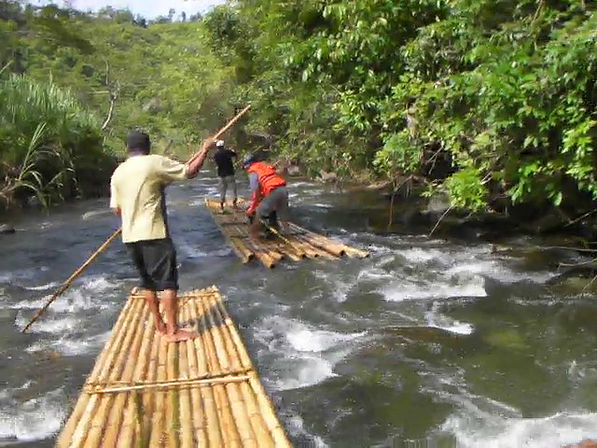
Kalimantan
Island of countless rivers
The second largest island of Indonesia is rightfully called the island of many rivers as some of Indonesia longest rivers rise in its mountains. The vast lowland plains merge in the interior into a mountainous area with peaks that reach not more than 2200 meter.
For the Dayak, the indigenous peoples of the interior and the Malay as the dominant coastal peoples live revolves around these rivers and therefore they have developed several types of river transportation, from bamboo rafts to two level high riverboats. Sadly, the rivers also allow an easy flow of logged tropical forest, where timber logs are tied together to form huge rafts that float downstream or are pulled by special boats to one of Kalimantan’s major seaports.
The tropical forest still found on Kalimantan is the most diverse in the archipelago and shows a high percentage of endemism. Here one can experience the word jungle in every respect of its meaning.
The Dayak form a heterogeneous population with many cultural differences between the several tribes. There are however also several similarities like the use of long stretched communal houses, worshipping of ancestors and spirits, (body) art which dominantly shows images of animals and a way of living using a method of slash and burn to grow agriculture products.
For traveling in Kalimantan one should be prepared to use any kind of river transportation to reach remote Dayak villages, the further away the more traditional they will be. There is adventurous trekking in its tropical rainforests.
See our example tours for inspiration on your Kalimantan adventure:
South Kalimantan
Banjarmasin, the capital of South-Kalimantan, is the main port of entry in the southern part of Kalimantan. Besides being a good base from which to
explore its surroundings, the city itself is definitely worth a visit. Beyond dispute one of its most interesting sights are the floating markets or pasar terapung that are held at several different locations. Here women sell their products in small canoes wearing big round palm leaf hats to protect them from the sun. For those buyers that become hungry or thirsty others sell cakes and drinks handed out with the use of a long stick. The islands Kaget and Kembang, a short distance by speedboat from Banjarmasin were inhabited by several groups of nose monkeys or bekantan, monkeys with red, pickle-like noses (only males) who are endemic to Kalimantan but nowadays all of them are replaced to Java leaving the islands to be inhabited by a more common species of monkey, the long tailed macaque.
The small town Martapura at a short distance from Banjarmasin is the center of the diamond trade. In its surroundings several mines can be found where people dig for the gems still using traditional methods.
Northeast from Banjarmasin are the Meratus-mountains. An area still partly covered by rainforest and the home to the indigenous Dayak Bukit of whom several still live in traditional communal houses. A good area for adventurous trekking and exciting bamboo rafting.
East Kalimantan
This province is the homeland of Kenyah and Kayan Dayak, from whom tattoos and elongated earlobes characterize their appearance. This body decoration is nowadays only found on the older generation and even among them many have cut their earlobes out of shame. East-Kalimantan is also the province of the great Mahakam River, one of Kalimantan’ s largest rivers. Following this river and its tributaries like the Telen River, you will be taken to typical Dayak villages were a small number of their inhabitants still occupy the well-known traditional longhouses. Dense jungle is still found here, however it will demand quite some effort to reach areas with extensive undisturbed tropical rainforests; the easy accessible areas near the rivers are logged by local people to make place for agriculture fields or by big companies for timber use.
The city of Samarinda at the estuary of the Mahakam and the small town of Tenggarong (the former seat of a once influential kingdom) further upstream, are both suitable as a starting point for trips into the interior of East-Kalimantan. To the north lies the town of Balikpapan, mainly known as a center of oil mining. This town plays a central role in transportation within and outside of East-Kalimantan, however the town itself does not offer a visitor a great deal of interesting sightseeing.
Not far from Balikpapan you can visit a special project of the Gibbon Foundation and BOS Foundation (Borneo Orangutan Survival Foundation), just recently accessible for visitors. Here in the recently replanted forest of Samboja Lestari, covering an area of around 2000 hectare, you find a rehabilitation centre for sun bears and orangutans. During walks through the fast growing vegetation and forest you can encounter several kinds of other wild primates, reptiles, small mammals and birds as well. It is possible that to join the staff working on the different projects available here.
Central Kalimantan
Foreign travelers, not in the least due to its poor infrastructure, visit this province not very often. The rehabilitation center for the large red haired orangutans, established in Tanjung Puting National Park enjoys international fame. Together with Bohorok, in North-Sumatra and Samboja in East-Kalimantan, this is the one of the few places in Indonesia where the apes are placed back in their natural habitat. Access to this park is only possible by chartered boat and while traveling up river your chances are considerable to encounter long nose monkeys, the red colored langur and perhaps some crocodiles. Within the boundaries of the park there is limited but good accommodation available, but best is to spend your nights on the boat and enjoy all the amazing sounds of a river forest during the night and early morning.
The inland Dayak people still adhere to their traditional beliefs known as kaharingan, an accepted religion that allows for great impressive funeral ceremonies.



